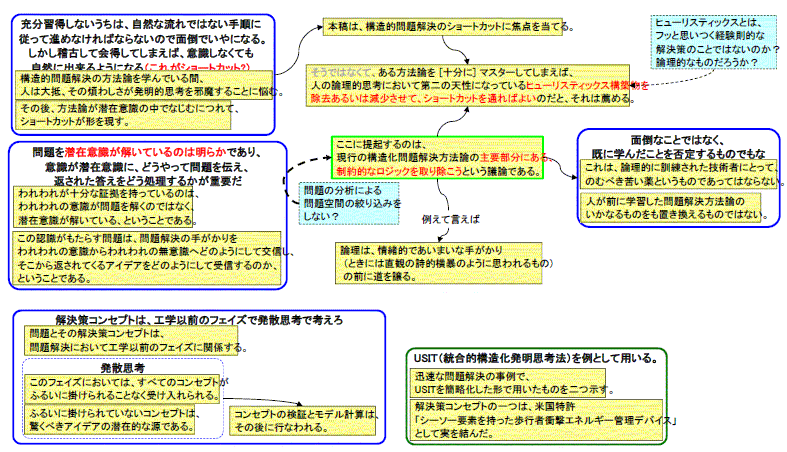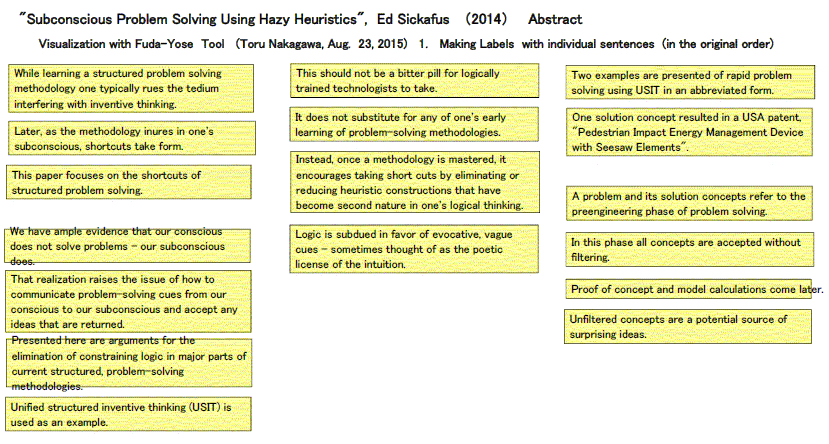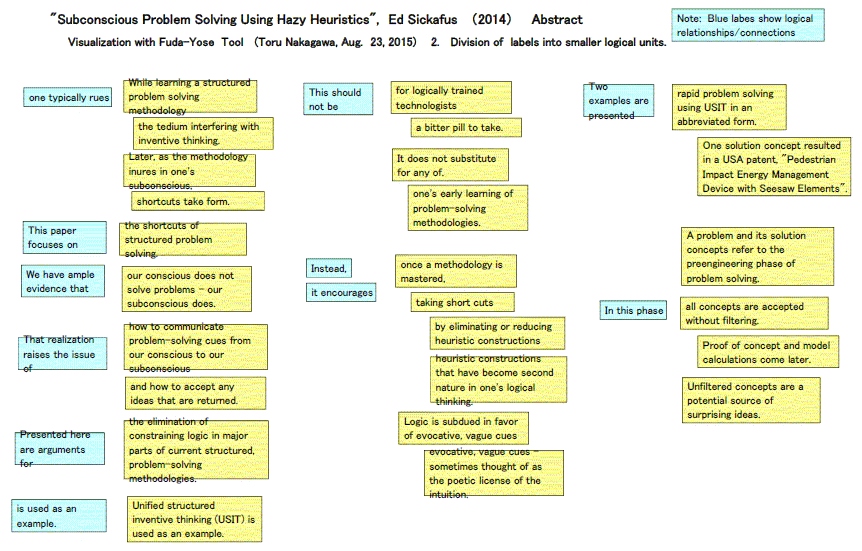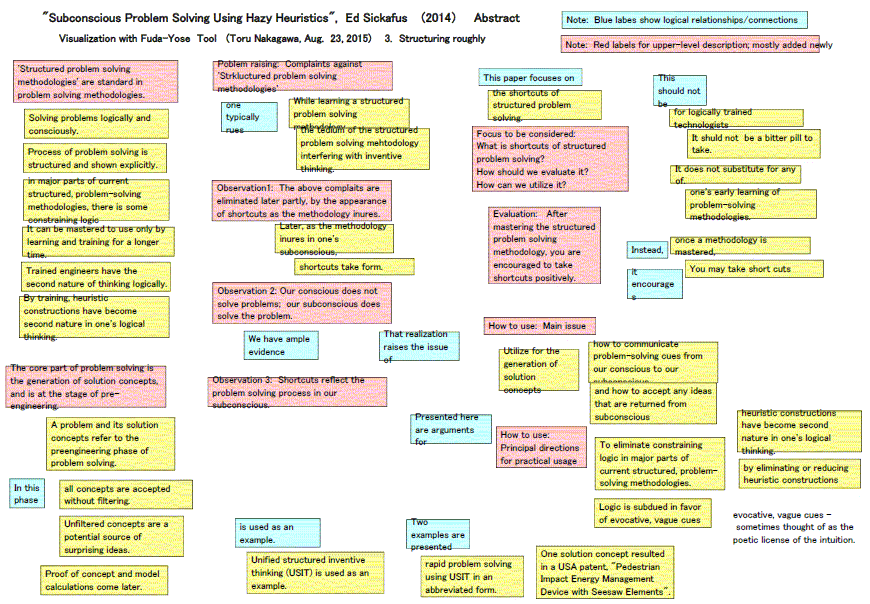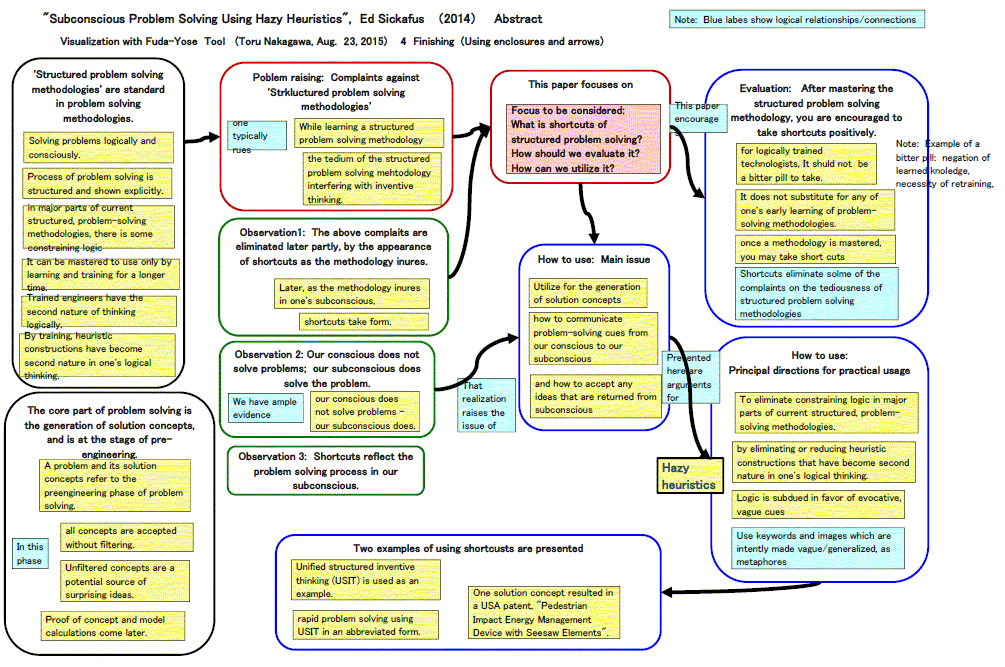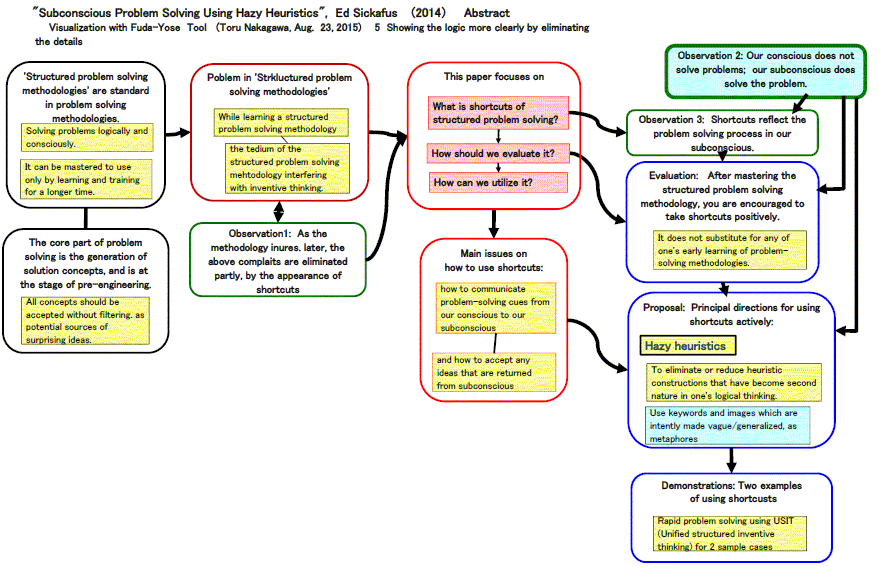This page is the results of efforts for better understanding Ed Sickafus' paper "Subconscious Problem Solving Using Hazy Heuristics" (Keynote at ICSI2014). Its Japanese translation verison was posted on Jul. 29, 2015 and original English version  on Aug. 25, 2015.
on Aug. 25, 2015.
(A) Akihiro Katahira is the developer of a 'Visual Thinking' tool, named 'Fuda-Yose Tool. The tool was introduced in this Web site in English  on Jan. 18, 2015. He has demonstrated how to use the tool by making Fuda-Yose diagrams of short documents in Japanese
on Jan. 18, 2015. He has demonstrated how to use the tool by making Fuda-Yose diagrams of short documents in Japanese  . Last month he, reading the Japanese translation version of Sickafus' paper, worked to visiualize the paper in its full length. All the sentences of the paper are made into labels (or Fuda) and their logical relationships are shown in 'Fuda-Yose' diagrams section by section. The diagrams are posted in this Web site (in the Japanese page)
. Last month he, reading the Japanese translation version of Sickafus' paper, worked to visiualize the paper in its full length. All the sentences of the paper are made into labels (or Fuda) and their logical relationships are shown in 'Fuda-Yose' diagrams section by section. The diagrams are posted in this Web site (in the Japanese page) in PDF for all the paper, and in HTML especially for the Abstract.
in PDF for all the paper, and in HTML especially for the Abstract.
(B) Nakagawa, reviewing Katahira's diagrams, thought that for clarifying the logic of a compact document like the Abstract we should decompose some sentences further into their logical units. So I applied the Fuda-Yose method to the Abstract. The visualization was actually done in 4 steps, i.e., (1) Copy the Abstract texts into an Excel file, and convert all the sentences into labels with a click in the Fuda-Yose Tool, (2) Divide some labels into smaller units of logics, especially picking up the phrases showing logical connections, (3) Rearrange the labels to show groups of labels and the structure of the document, and (4) finish the diagram by using enclosures and arrows. The intermediate records and the final Fuda-Yose diagram were posted in the Japanese page  in HTML, PDF, and Excel files.
in HTML, PDF, and Excel files.
(C) Nakagawa have worked on Sickafus' original English text to make the Fuda-Yose diagram with reference to the Japanese version. In the present page are posted the original text, draft diagrams in the intermediate steps, and the final Fuda-Yose diagram in English, in the formats of HTML (with images), PDF  , and Excel
, and Excel  . Please compare the final Fuda-Yose diagram with the original text of Sickafus' Abstract.
. Please compare the final Fuda-Yose diagram with the original text of Sickafus' Abstract.
(D) I sent the Fuda-Yose diagrams to Dr. Ed Sickafus in advance to the present posting. His comment is shwon below, together with short Q&A. 
(E) [Note (Sept. 12, 2015)] After some communications with Dr. Shahid Saleem Arshad, I revised the final Fuda-Yose diagram a step further to make the logic clearer by suppressing some details. The revised final diagram is shown below.
(F) Katahira and I are currently working to make an English version of the Fuda-Yose Tool itself for public use.
 Editor's Note (Toru Nakagawa, Mar. 2016) Further extension of Visual Thinking
Editor's Note (Toru Nakagawa, Mar. 2016) Further extension of Visual Thinking
The Visual Thinking with 'Fuda-Yose' Tool has been used intensively by Toru Nakagawa on a social problem: "Thinking over the poverty in the Japanese Society: [A] Increasing poverty among the elderly", See 
 and
and 
 (Mar. 6, 2016)
(Mar. 6, 2016)
English edition of the 'Fuda-Yose' Tool has been made available. See the Instructions of the tool in the page: "Fuda-Yose Tool for Visual Thinking -- English Edition Available"  (Sept. 17, 2015; updated: Mar. 6, 2016). The 'Fuda-Yose' Tool may be downloaded without charge from Akihiro Katahira's Web site:
(Sept. 17, 2015; updated: Mar. 6, 2016). The 'Fuda-Yose' Tool may be downloaded without charge from Akihiro Katahira's Web site:  . Its current version is 4.0.1.
. Its current version is 4.0.1.
(0) Original English Text of Sickafus' Abstract
While learning a structured problem solving methodology one typically rues the tedium interfering with inventive thinking. Later, as the methodology inures in one’s subconscious, shortcuts take form. This paper focuses on the shortcuts of structured problem solving.
We have ample evidence that our conscious does not solve problems – our subconscious does. That realization raises the issue of how to communicate problem-solving cues from our conscious to our subconscious and accept any ideas that are returned. Presented here are arguments for the elimination of constraining logic in major parts of current structured, problem-solving methodologies. Unified structured inventive thinking (USIT) is used as an example.
This should not be a bitter pill for logically trained technologists to take. It does not substitute for any of one’s early learning of problem-solving methodologies. Instead, once a methodology is mastered, it encourages taking short cuts by eliminating or reducing heuristic constructions that have become second nature in one’s logical thinking. Logic is subdued in favor of evocative, vague cues – sometimes thought of as the poetic license of the intuition.
Two examples are presented of rapid problem solving using USIT in an abbreviated form. One solution concept resulted in a USA patent, “Pedestrian Impact Energy Management Device with Seesaw Elements”.
A problem and its solution concepts refer to the pre-engineering phase of problem solving. In this phase all concepts are accepted without filtering. Proof of concept and model calculations come later. Unfiltered concepts are a potential source of surprising ideas.
Toru Nakagawa ==> Ed Sickafus Sept. 1, 2015
Dear Ed,
I have just made an English translation version of my Fuda-Yose Diagram posted on Aug. 25 in Japanese. Abstract of your 'Subconscious Problem Solving..." is illustrated in English. Excel and PDF files are attached.
I am working to use Fuda-Yose Tool for various purposes.
(1) I found the Fuda-Yose Tool and Fuda-Yose method, developed by Akihiro Katahira, very useful and convenient. See the page: Introduction to Visual Thinking Software 'Fuda-Yose Tool' and Its Web site 'Thinking School I' (Akihiro Katahira)  .
.
So I and Akihiro are now trying to make demonstrations of its usage.
(2) Comparison of written documents and visualized diagrams in Fuda-Yose is illustrative. It is especially important to show how to visualize written documents in illustrative diagrams. Abstract of papers seems to be suitable in size to convert into the diagrams. So I would like to work some more on other short documents.
(3) In response to Shahid's message, I worked for the English translation of my diagram. Akihiro and I have started to make the English version of the Fuda-Yose Tool itself. The tool is written as macros of Excel in Visual Basic. So the conversion can be done without much difficulty.
(4) I am thinking to use the Fuda-Yose diagrams as the communication documents for discussing non-technical delicate and complex issues, such as social problems (in Japan). By the visualization, we can discuss delicate & complex issues in some more logical manner, while keeping records of discussions.
Best wishes, Toru
Ed Sickafus ==> Toru Nakagawa Sept. 3, 2015
HI all, I read the PDF file of Fuda-Yose diagrams of my Abstract  [Note. diagrams up to (4)] and was impessed.
[Note. diagrams up to (4)] and was impessed.
But how was it done? How much human intervention was required? Ed
Toru Nakagawa ==> Ed Sickafus Sept. 1, 2015
Dear Ed, Thank you for your interest in the Fuda-Yose method.
(1) Fuda-Yose is done on the Excel file I attached to the last message. 'Fuda-Yose Tool' is actually another Excel file having a special macro installed. -- This tool is currently in Japanese and we are working to translate it into English. Please give us several days.
(2) Making sentences (i.e. in the Sheet 'Abstract-Text') into labels (in the Sheet 'Abstract-Labels') is done in one click. Handling labels is easy but should be done by the user: Including: Changing the size, moving a label (or a group of labels), creating a label, converting a label into an enclosure, creating an arrow, etc.
(3) All other works of layouting and structuring the diagram, dividing a label into two labels having meaningful contents, enclosing several labels by changing the size of an enclosure, etc. are done by the user. No intelligent assistance by the tool.
(4) I do not have a record how long it took for me to make the Fuda-Yose Diagrams. But probably: Making the Japanese version: 5 - 6 hours; Making the English version (with reference to the Japanese version): 3 - 4 hours. Note that this was my first experience of making this size of Fuda-Yose diagram. Once I get used to the tool and the method, the work of the Japanese version may take 3-4 hours, I guess.
(5) Akihiro made Fuda-Yose diagrams of the full paper of Ed's "Subconscious Problem Solving with Hazy Heuristics" by using the labels of all the sentences, in Japanese. See the HTML page, where small images and the PDF file are posted.  Akihiro did this work between Jul. 30 and Aug. 10. He will answer how many hours he actually spent for the work.
Akihiro did this work between Jul. 30 and Aug. 10. He will answer how many hours he actually spent for the work.
Best wishes, Toru
[Note (TN, Sept. 12, 2015): The Fuda-Yose diagram was further revised in one more step by suppressing some details and showing the structure more clearly.]
